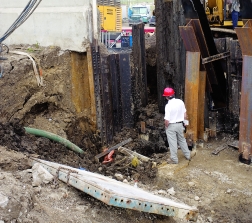An internal ASCE ethics probe absolved the organization and its members of charges of misconduct related to assessment of the New Orleans Hurricane Protection System following Hurricane Katrina.
 |
The probe also found no misconduct in ASCE’s peer review of the Interagency Performance Evaluation Task Force, which was a broad look at the causes of the disaster. Carried out by the American Society of Civil Engineers’ Committee on Professional Conduct, the probe was a response to charges in a complaint by Raymond Seed, a civil engineering professor, filed in 2007.
Rich Hovey, who chairs ASCE’s ethics committee, says the committee made no misconduct charges as a result of its inquiry, and ASCE President D. Wayne Klotz sees the findings as an affirmation. “As engineers sworn to protect public health, safety and welfare, it is imperative that the public have confidence in our work,” says Klotz. “The work of the Committee on Professional Conduct should reaffirm confidence in the findings and recommendations generated by the significant body of scientific research related to the performance of the New Orleans Hurricane Protection System.”
Klotz says the practice of civil engineering requires the exchange of ideas and professional debate. “We respect the dedication to the profession of all of the individuals involved in this matter and, despite the sometimes painful public debate surrounding these allegations, believe that our profession is stronger as a result,” Klotz says.
The charges of ethical misconduct were originally made by Raymond Seed, a civil engineering professor at the University of California-Berkeley, who filed a 42-page letter of complaint to the former ASCE president in October, 2007. Seed claimed that the Corps-sponsored investigation after Katrina absolved the Corps of some responsibility in the disaster and led to mistakes in rebuilding levees and floodwalls.
Seed, along with New Orleans area non-profit organization Levees.org, later accused the ASCE of ethical violations because the organization received $1.1 million in Corps funding to peer review IPET. In September 2008, an independent task force formed by the ASCE task force recommended changes in the way future funding is handled. Seed and Levees.org also argued that the ASCE is in collusion with the Corps and, therefore, could not perform an acceptable third-party peer review. The CPC is a standing committee of the ASCE, says Joan Burhman, a spokeswoman for ASCE. “The CPC shall consist of at least four members, all of whom shall be past society directors who represent no less than four geographic regions,” Buhrman says.
Following a 13-month investigation, which included numerous personal interviews and reviewing thousands of e-mail communications and hundreds of pages of print documents, the CPC dismissed all charges of ethical misconduct. The CPC’s only findings were of two technical errors in a June 1, 2007 press release entitled "Move Beyond Sound-Bites and Armchair Theories to Make the Nation Safer from Disaster, Engineers Say." The press release refers to a report of ASCE's External Review Panel which the CPC report states “inadvertently conveyed a misleading impression regarding the role of engineering failures in the devastation of New Orleans in two ways.
One way, according to the report, was by asserting that "[t]he surge level in coastal Mississippi exceeded that of the Indian Ocean tsunami of December 2004," when in fact, the height of the Indian Ocean tsunami was greater than the surge level in coastal Mississippi during Hurricane Katrina. This resulted from a mathematical error discovered in the course of CPC’s interview with the document’s technical editor.
The report says another misleading reference by the external review panel, which was later clarified, was when it incorrectly cited a scenario from the Interagency Performance Evaluation Task Force estimating deaths and property damage in New Orleans that would have occurred even if the floodwalls had not breached. The referenced hypothetical scenario was based on assumptions that the levees breached as in Hurricane Katrina, interior pumping was as occurred in Hurricane Katrina, but that no breaching of floodwalls occurred.The IPET hypothetical scenario referenced within the ERP report assumed no breaching of the levees or floodwalls and 100 percent pump operation. The CPC found that a clarification issued on June 15 insufficiently addressed this issue.”
Seed did not reply by press time to telephone and e-mail requests to comment on the CPC report. However, at an April 8 press conference hosted by Levees.org, H.J. Bosworth, a civil engineer and Levees.org research director denounced the CPC findings. “The ASCE administration is apparently corrupt and only interested in public relations to make sure the civil engineering profession doesn’t have a black eye and the Corps doesn’t have a black eye,” Bosworth says. “Levees failed. People died. No one I know has been brought to justice. Until someone is brought to justice, I think Levees.org has their work cut out for them.”
Levees.org founder, Sandy Rosenthal, even went so far as to say that certain local engineers claimed to have been threatened by members of the USACE. “Any who speak out against the U.S. Army Corps of Engineers will be silenced and muzzled,” Rosenthal says. Levees.org won’t rest until an 8/29 commission is established to investigate the failures during Katrina. “We all deserve a study that isn’t drowning in controversy,” she says.

Post a comment to this article
Report Abusive Comment